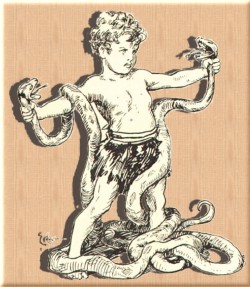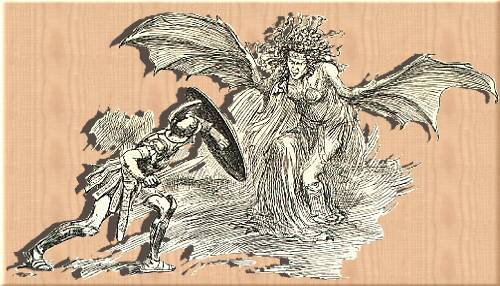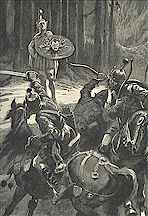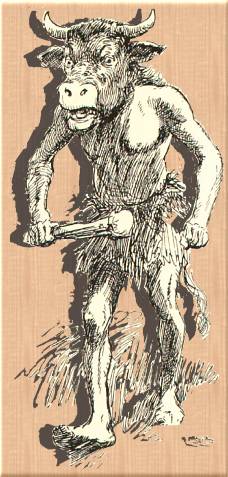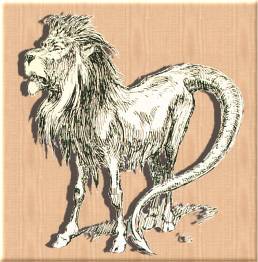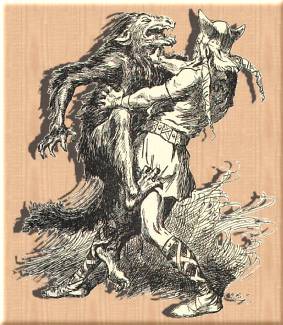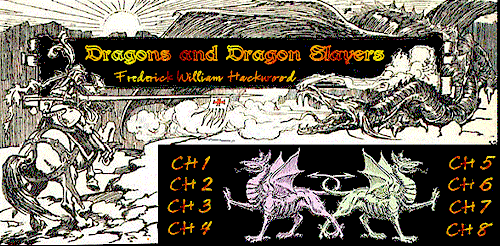
![]()
CHAPTER FOUR
~ Dragon
Slayers of Mythology ~
![]()
|
BESIDES hagiology, or system of legendary saints and holy persons, another rich source of dragon-lore is found in the mythology, or system of invented fables embodying the notions of certain pagan nations of antiquity concerning the lives and characters of their numerous gods and divine personages. This remark applies to the classical mythologies of the ancient Greeks and Romans, and also to Norse mythology, or religious beliefs of those primitive northern peoples to whom the Anglo-Saxons belonged. In classical story the dragon as the symbol of Evil or Deadly Peril is not used with so much frequency, its place being taken sometimes by the serpent or by some other strange beast of frightful aspect. From the earliest times the serpent has been used in this way, as the story of the "Temptation in the Garden of Eden" testifies. In the classical story of Hercules it is employed as the symbol of the dangers which threaten all infantile life when the human frame is so weak and tender. Thus in the life of the Greek god of Strength, we read that Hercules, when about a year old, was rocked to sleep with a baby brother in their father's upturned shield in which they were one day left alone in the house. As the two unprotected infants lay wrapt in the happy slumbers of innocence, two huge serpents crawled into the room from the garden. As the deadly beasts approached the sleeping children, one awoke and raised a cry of fright which roused the other. Then the child Hercules, using both hands, grasped each
the children were quite unharmed. When Hercules grew to full manhood his prodigious strength became a marvel to the world. He was recognised as a great hero, and among twelve tasks of difficulty and danger set him, by the performance of which he might achieve immortality, was to destroy a monstrous dragon and gain possession of the golden apples which it guarded. It was in the fabled garden of the Hesperides that these golden apples grew, closely guarded by the vigilant dragon Ladon. Hence the allusion of the old dramatist, Robert Greene, of Shakespeare's time : "Shew
thee the tree, leafed with refined gold, Of the many other mighty deeds and wonderful adventures of this hero we have nothing further to say here, as they are outside the scope of our subject ; but when opportunity serves they are well worth reading. The classical god Mercury is always depicted with a peculiar kind of wand in his hand. This wand, called his Caduceus, is composed of two dragons, the one male and the other female, strangled at the middle. Now, Mercury was said to be the inventor of Astronomy, and the solstices (that is, Midsummer-day and Midwinter-day) were anciently called "the head and the tail of the dragon" ; so that the emblem of the Caduceus would appear to have some hidden meaning in allusion to the two solstices. Among the strange monsters of classical legend we have the Gorgon, the Chimaera, and the Minotaur. Under the title of The Heroes, or Greek Fairy Tales, Charles Kingsley wrote a book for the pleasure and instruction of his own children, in which are included the stories of Perseus and of Theseus, the first of whom slew the Gorgon, and the other killed the Minotaur. To Perseus appeared one day in a wood the beautiful goddess, Pallas Athené, who knows the hearts of men and discerns their manhood or their baseness, who to souls of fire gives more fire, so that they may become heroes, the blest sons of the Immortals. To Perseus she offered the choice of fighting the Titans and the monsters, the enemies of the gods and me ; to go through doubt and danger, through need and through battle, ready to die in the flower of youth ; or to win a noble name for a fair and green old age. It was to be a seven years' journey in which he could not repent or turn back or escape ; but if at any moment his heart failed him, he would die in the Unshapen Land where no man would even find his bones. To this offer Perseus boldly answered, "Better to die in the flower of youth on the chance of noble name, than to live at ease like the sheep, and die unloved and unrenowned." At this Athené smiled, and then instructed him to go northward to the Country of the Hyperboreans, where the cold north wind lurks, and there to inquire of the Three Grey Sisters, who have but one eye and one tooth between them, who would tell him the way to the Nymphs, the Daughters of the Evening Star, who dance about the Golden Tree in the Atlantic Island of the west. Said Athené, "They will tell you the way to the Gorgon, that you must slay her, my enemy, the mother of monstrous beasts." Now, the Gorgon was once a beautiful maiden till in her pride she sinned, and from that day her hair was turned into vipers, and her hands to eagle's claws ; her heart was filled with shame and her lips with bitter venom. Her eyes became so terrible that whosoever looked upon them was frozen into stone. So she became the sister of the Swinish Gorgons and was called Medusa. "Touch them not," said Athené, "for they are immortals. Bring me only Medusa's head." Then she gave him a polished brazen shield and a goat's skin, with this caution - "Look not on Medusa's face or her glance will turn you to stone. When you come near her, look only at her image on the face of the shield, and then you may strike at her with safety. And when you have struck off her head, wrap it, with your face turned away, in the folds of the goatskin. Bring it thus safely to me and win for yourself a place among the Immortals." And so he set forth on his adventures. After passing through many dangers and looking on many frightful sights, he came upon three sleeping Gorgons as huge as elephants, very terrible to look at. One who tossed to and fro restlessly in her sleep while the others slumbered heavily, he recognised as Medusa, who was as a beautiful woman, though her cheeks were pale as death, her brows knit with everlasting shame, and her lips thin and bitter as a snake's ; about her temples instead of hair wreathed vipers that shot out their forked tongues ; round her head were folded eagle-like wings of rainbow plumage, and folded upon her bosom were claws of brass.
The beauty of her face made it seem hard to strike her, but as he looked the vipers of her tresses awoke, displayed their fangs and hissed menacingly as they peeped through their wicked eyes ; and when she threw back her wings and showed her brazen claws Perseus perceived that for all her beauty she was as venomous and deadly as the rest. So covering up his eyes and gazing steadily into the mirror of his shield, he stepped boldly to the attack, and struck so stoutly that he needed not to strike again. Medusa's head was stricken right off, and as she fell dead her fearsome wings and talons rattled on the rocks. Turning away his eyes, he wrapped the head of the beautiful horror in the goatskin, as he had been carefully instructed. Pursuing his journey, many more adventures of a strange and surprising nature were encountered by the heroic Perseus. Once
powerful and moving story of adventure as can be given here. How Perseus afterwards happily married Andromeda is another portion of one of the most wonderful tales in the world ; by us he is to be remembered as the renowned slayer of the Gorgon. The other famous classical story of monster slaying is that of Theseus and the Minotaur ; and in this case the awesome beast has none of the common features and characteristics of the dragon except its ferocity and hideousness. The Minotaur, though a fearful monster which fed on human flesh, had nothing of the appearance of the dragon or of the more familiar serpent about it ; it was a creature
adventures, came Theseus, Prince of Athens, having with him seven youths and seven maidens, yearly tribute of Athens to Minos, King of Crete ; demanding to be the first of them thrown to the beast. And when the Minotaur rushed upon the daring champion with the teeth and roar of a lion, Theseus deftly caught him by the horns, forced his head back, and plunged through his throat the enchanted sword given him by Ariadne, daughter of Minos, who loved him ; and with whom he afterwards safely escaped, as well as opening all the prisons and setting free the seven youths and seven maidens kept in captivity there. For in this strange and perilous adventure there was more than hard fighting to be done ; there was the problem of ever getting out of that bewildering labyrinth again, if life remained. So that the hero of this tale had not only to confront the monster ; he had to contrive a plan for the ultimate escape. This Theseus did very cleverly, knowing that unaided he could never hope to find his way out of that gloomy maze. So he had taken with him a ball of twine which he fastened to a stone at the entrance, unrolling it as he proceeded through the winding paths and galleries of that sunless glen ; never losing his confidence among the most ragged rocks or at the sharpest turnings and twistings. It was just when the whole of the twine was unrolled that he came suddenly upon the terrible monster in the very heart of the maze. By this precautionary and cunning plan was the escape after victory effected, and all ended happily. Lastly, mention must here be made of the Chimaera. This is the name given by the Greek poet, Homer, to a beast so strangely and fantastically formed that we now use the word "chimaera" to stand for any wild and fanciful scheme of the imagination.
is
almost as bad as having a waking Again, in Egyptian mythology we find the same idea persisting of a dragon used as the emblem of darkness, and a delivering hero as the symbol of light, where it is taught that Horus, son of the goddess Isis, slew a great dragon of Evil. Always is there the same moral purpose, to teach the triumph of good over evil. It is worthy of note that the Egyptian god Horus is frequently represented on horseback, piercing a crocodile with his lance ; just as we see in the familiar design St. George attacking the dragon from a more or less precarious seat on the back of a prancing charger. In Norse mythology appears a celebrated hero named Beowulf, who killed two semi-human man-eating monsters, and as a last mighty effort slew a fiery dragon, though he died from the poisonous bite of the dreadful creature. In those ancient times the King of Denmark was Hrothgar, who gained great glory in battle and gathered round him a band of brave warriors, for whose accommodation he built a vast and lofty palace of wood, with wide gables, in which they could all feast and rejoice together after their hard-won victories. Now, near this great hall, which was named Heorot, was a wide open moor stretching away into still wilder fens and swamps, and here lived a monster called Grendel, whose fiercest hatred was provoked by seeing men enjoy the good things of life. One night, after the warriors had held high revel and their mirth had aroused Grendel to the highest pitch of hatred, the monster stole into the dark and silent hall after the revellers had lain down to sleep, seized thirty of them, carried them away to his den and devoured them. For twelve years did Grendel repeat these dreaded visitations, and though Hrothgar went out to fight him, he never could slay him, or overcome him, no matter what plan he tried. This sad story of repeated failure at last reached the ears of Beowulf, the bravest and strongest of all living men, whose home was in a far-away northern country, and Beowulf at once determined to sail the seas to Denmark, to go to Hrothgar's rescue. When the hero and his band of comrades landed and saw the hall of Heorot, they were astonished, and thought it the largest and finest building on earth. The adventurer assured the king that he came not only as a friend, but with the set purpose of encountering the cruel monster in an attempt to free the land for ever from its awful scourges. So one night the hero lay down in the hall with his own warriors around him, first doffing his armour, having resolved to undertake the great combat unarmed. In the dead of night the prowling monster came, seized one of the sleeping men and tore him to pieces ; but when he next attacked Beowulf, the hero, who had kept awake, seized the outstretched arm of the fiend, and held in a grip of iron. Then commenced a struggle which nearly shook the great oaken hall to pieces. When the king's men rushed in to the assistance of the champion, Grendel's mighty magic rendered the blades of their swords powerless. Beowulf then put forth his strength to the very utmost, and tore off the arm of the foul beast ; whereupon the maimed monster rushed out, sick to death, and in the morning was found lying dead in a pool of blood-red waves. But all the danger had not yet passed. In a gloomy lake amidst the fens lived Grendel's mother, a wolf-like witch as powerful and as wicked as her son, whose death she resolved to avenge. She commenced to seize and carry off the warriors as he had done ; so Beowulf now undertook to do battle against her. This time he armed himself, and riding across the wild moorland came to the blood-stained pool in which the witch-mother lived, closely guarded by many sea-dragons. Slaying the first of these guards, he plunged into the lake where the witch lay at the bottom awaiting him. With her fierce horned claws she seized the enemy firmly, but as he was clad in proof armour she failed to do him the least injury, though she dragged him into the dark depths of the water-cave in which she dwelt.
breastplate alone prevented. As Beowulf recovered his feet after one attack, his eyes caught sight of an old sword of immense size and weight hanging on the wall ; quickly seizing it, he dealt his grim enemy a fearful blow on the neck, and as it was the monster's own magic blade, the single stroke was sufficient, for she fell dead at once. After being laden with rich gifts and all manner of honours and rewards, Beowulf sailed away in great triumph. Many other adventures befell this hero of high renown. In after-years, when he had reigned long in a peace over his own people, a strange fiery dragon appeared in the midst of his land flying swiftly across, spitting out coals of fire, which burned up the fair dwellings of the realm and caused great distress among the people. So once more Beowulf donned his armour, buckled on his sword, and went forth to do battle against a monstrous enemy. But, alas ! though the gallant Beowulf slew the dragon, the venomous beast bit the hero in the neck, from the deadly effects of which he died. His people did their departed hero every honour their customs taught them to render : they burnt his body on a tall cliff overlooking the sea, and there raised a great mound over his ashes, to remind future generations of the mighty deeds done by valiant Beowulf in the brave old days of old. One of the most famous heroes of ancient Germany was Siegfried the Dragon Slayer, whose prowess is set forth at great length in the Nibelungenlied, a Teutonic poem of the thirteenth century based on a much older northern saga, a Norse composition of traditional history. The legendary history of Siegfried is very full and fantastic, and above all very heroic ; it has been used as the theme of magnificent grand opera by the German musician Wagner. "Yet
more I know of Siegfried that well your ear may hold, In another part of the legend Siegfried kills a giant in the guise of a dragon guarding the Nibelungen hoard of gems and gold ; and, tasting of the dragon's blood, is able to understand the language of birds. Both in song and story the Germans make much of their hero Siegfried. Their city of Worms is said to have derived its name (the word "worm" signifying a serpent or dragon) from the tradition that this was the place where the dread monster was slain by him under a lime-tree. Also the Drachenfels, the well-known "Dragon-rocks" overlooking the River Rhine, claim a similar distinction. Thus sings Lord Byron in his poem, "Childe Harold" - "The
castled crag of Drachenfels In German mythology a dragon without wings was called a Lintworm, that is a beautiful shining worm ; conveying the idea of glinting gold or silver scales. |
